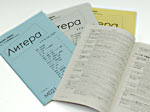-

<中東欧>戦間期アヴァンギャルド演劇レキシコン (英語)
A Lexicon of the Central-Eastern European Interwar Theatre Avant-Garde. (in English)./ red. Dariusz Kosiński; Wyd.1. (Odzyskana Awangarda)
Warsaw, The Zbigniew Raszewski Theatre Institute 647 c. hard2023 年 ISBN 9788367682176 R259176
ワルシャワ<スビグネフ・ラシェフスキ演劇研究所>刊。戦間期の中東欧地域(旧ソ連圏)でアヴァンギャルド演劇運動がどのように展開されたかを追究した学術書。 A Lexicon of the Central-Eastern European Interwar Theatre Avant-garde presents different aspects of the theatre avant-garde programmes, projects and achievements that took place between the two World Wars in a region of Europe that, squeezed between the two mighty powers of Germany and Russia, experienced similar historical dangers of marginalization and (in many cases literal) colonization and conquest.
The book uses the idea of a lexicon in an unexpected way: Instead of a dictionary of terms, phenomena, names, events, works, etc., creating a historical entity introduced by a title and organized in alphabetical order, the international team of researchers and editors have used the idea of lexicon as a tool to establish something that has not previously been clearly recognized as being separate, specific or autonomous, to constitute a specific historical phenomenon. Thus the lexicon is not a dictionary – it is a performance.
The Lexicon aims to present and establish the phenomenon of the Central-Eastern European interwar theatre avant-garde. This does not mean it creates something that did not previously exist. Rather it (re-) establishes a certain set of elements in such a way that they emerge from an array of different, multi-layered and complicated webs of relations, events, works, projects and circumstances. But they are emerging not as one unit, a single phenomenon, but as a multiplicity invited to act, to perform on the stage that has been designed for them. And this is something quite different from the traditional academic definition, in which one seeks borders and criteria of differentiation and division. In contrast, while performing a phenomenon the book invites different elements to appear on a stage and play with each other like actors to create a series of changing relations.
Being a performance on performance art, the Lexicon follows a special dramaturgical composition, created intentionally to play with drama and theatre conventions. The main body of the book consists of three sections (or acts). The first presents the stages of the Central-Eastern European interwar theatre avant-garde, I.e. the historical and cultural conditions that created an environment in which the avant-garde theatre of the region was developed. Here one can also find short presentations of the main characters — the national theatre avant-gardes that we invited to perform the phenomenon of the Central-Eastern European interwar theatre avant-garde.
The second section of the Lexicon may be seen as an antithesis of the first. What is described in it are not the separate national stages created by specific political and historical conditions, but modern networks of communication working across political borders and cultural differences: magazines, exhibitions, the international working-class movement and Jewish theatre as a special transnational phenomenon.
The third section proposes a synthesis of the whole performance of the Lexicon. It is here that the Central-Eastern European interwar theatre avant-garde appears and acts as an entity enlivened by common aesthetics, values, ideas, modes of work, passions and goals. This part is organized around four general terms: form, drama, dance and event, which hopefully allow description of the specific aspects of the Central-Eastern European interwar theatre avant-garde seen as an autonomous subject with its own agency.
The book is composed of texts written by different authors from different cultures and styles of writing. Its editors tried not to hide this multiplicity by forcing an ‘objective’ unification – quite the opposite. To help the reader to navigate between these different voices and perspectives the editors have created a special Index, listing the main figures, events, performances and ideas of the Central-Eastern European interwar theatre avant-garde.
A Lexicon of the Central-Eastern European Interwar Theatre Avant-garde is the result of long-term project realized from 2014 under the auspices of the Raszewski Theatre Institute and, in its final phase (2018–24), financed by the Polish Minister of Education and Science in the frame of Narodowy Program Rozwoju Humanistyki (National Programme for the Development of Humanities),価格(税込み) \25,960
在庫を超える数量の場合は、ご相談とさせていただきます。

![NAUKA JAPAN [店内にロシア書籍5000冊以上を常備ロシア書籍・新聞雑誌・映画DVD・朗読CD・地図他、欧米書籍]](materials/copy/top_copy1.gif)
![NAUKA JAPAN [店内にロシア書籍5000冊以上を常備ロシア書籍・新聞雑誌・映画DVD・朗読CD・地図他、欧米書籍]](materials/book11.jpg)


![NAUKA JAPAN [店内にロシア書籍5000冊以上を常備ロシア書籍・新聞雑誌・映画DVD・朗読CD・地図他、欧米書籍] 店舗外観](materials/image02.jpg)
![NAUKA JAPAN [店内にロシア書籍5000冊以上を常備ロシア書籍・新聞雑誌・映画DVD・朗読CD・地図他、欧米書籍] 店内イメージ](materials/image03.jpg)
![NAUKA JAPAN [店内にロシア書籍5000冊以上を常備ロシア書籍・新聞雑誌・映画DVD・朗読CD・地図他、欧米書籍] 店内イメージ](materials/image04.jpg)






